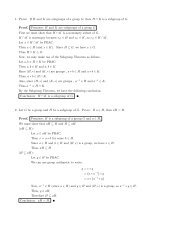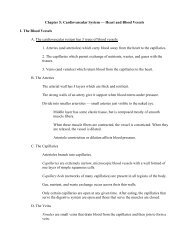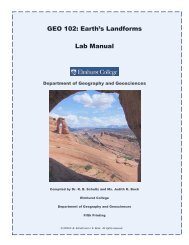Construction of an Anaerobic Gassing Station to ... - Elmhurst College
Construction of an Anaerobic Gassing Station to ... - Elmhurst College
Construction of an Anaerobic Gassing Station to ... - Elmhurst College
Create successful ePaper yourself
Turn your PDF publications into a flip-book with our unique Google optimized e-Paper software.
Marsh, T. L. 4 <strong>of</strong> 7<br />
<strong>to</strong> 150° C, would remove <strong>an</strong>y oxygen molecules from the flow <strong>of</strong> gas by causing a<br />
chemical reaction between the copper <strong>an</strong>d oxygen <strong>to</strong> give cuprous oxide. Gas<br />
exiting the column would be free <strong>of</strong> oxygen <strong>an</strong>d safe for use in the cultivation <strong>of</strong><br />
strictly <strong>an</strong>aerobic bacteria. This oxygen-free gas would move through copper tubing<br />
<strong>to</strong> exit at either a m<strong>an</strong>ifold or c<strong>an</strong>nula port. In a m<strong>an</strong>ifold system, a series <strong>of</strong> 6-8<br />
outlets would allow <strong>an</strong> exch<strong>an</strong>ge <strong>of</strong> headspace gases in sealed vessels when<br />
combined with the action <strong>of</strong> the vacuum pump. By this system, existing gas in a<br />
sealed bottle could be vacuumed out <strong>an</strong>d replaced with oxygen-free gas. Use <strong>of</strong> the<br />
c<strong>an</strong>nula would allow oxygen <strong>to</strong> be flushed out <strong>of</strong> syringes or other equipment<br />
necessary <strong>to</strong> h<strong>an</strong>dle <strong>an</strong>aerobic org<strong>an</strong>isms. Removing all oxygen from syringes<br />
allows safe passage <strong>of</strong> the org<strong>an</strong>isms from one vessel <strong>to</strong> <strong>an</strong>other without loss <strong>of</strong><br />
biomass due <strong>to</strong> oxygen exposure. I will be building the gassing station myself with<br />
supplies purchased from this gr<strong>an</strong>t. As I am not teaching this summer, I c<strong>an</strong> focus<br />
on construction <strong>of</strong> this equipment.<br />
Upon completion, the gassing station will be used <strong>to</strong> establish <strong>an</strong> <strong>an</strong>aerobic<br />
microbiology research program at <strong>Elmhurst</strong> <strong>College</strong>. One avenue that this research<br />
would take would be <strong>to</strong> study <strong>an</strong>aerobic tr<strong>an</strong>sformation <strong>of</strong> heavy metals. I have<br />
studied this subject for some time, determining the physiochemical conditions<br />
necessary for hexavalent chromium reduction <strong>to</strong> occur in a contaminated aquifer. At<br />
the conclusion <strong>of</strong> my graduate career, I was working with a mixture <strong>of</strong> bacteria which<br />
was able <strong>to</strong> use hydrogen as <strong>an</strong> energy source <strong>to</strong> reduce hexavalent chromium <strong>to</strong> a<br />
non-<strong>to</strong>xic form. This consortium grew <strong>an</strong>d carried out the reduction in only 4-5 days,<br />
making it the fastest <strong>an</strong>aerobic chromate-reducing consortium reported in the<br />
literature. Working <strong>to</strong> continue isolation <strong>an</strong>d characterization <strong>of</strong> individual chromatereducing<br />
org<strong>an</strong>isms from this mixture will be the major research focus <strong>of</strong> this project.<br />
I also wish <strong>to</strong> exp<strong>an</strong>d my studies specifically <strong>to</strong> meth<strong>an</strong>ogenic bacteria, which gain<br />
energy by metabolizing hydrogen (H2) <strong>an</strong>d carbon dioxide (CO2) <strong>to</strong> form meth<strong>an</strong>e<br />
(CH4). These org<strong>an</strong>isms are among the most fastidious <strong>of</strong> the strict <strong>an</strong>aerobes <strong>an</strong>d<br />
grow at very low redox potentials. Meth<strong>an</strong>ogens have never been shown <strong>to</strong><br />
tr<strong>an</strong>sform metals but molecular sequencing has shown that they possess heavymetal<br />
reductases <strong>an</strong>d heavy metal ATPases (enzymes that reduce heavy metals<br />
<strong>an</strong>d form adenosine triphosphate [ATP], respectively). It would be logical for these<br />
org<strong>an</strong>isms <strong>to</strong> have metal tr<strong>an</strong>sforming abilities since they are among the most<br />
primitive org<strong>an</strong>isms on Earth, having existed in the “primordial soup,” <strong>an</strong><br />
environment high in heavy metals <strong>an</strong>d devoid <strong>of</strong> oxygen. This research project<br />
would take time because most <strong>of</strong> the <strong>an</strong>aerobic bacteria grow more slowly th<strong>an</strong><br />
aerobic org<strong>an</strong>isms (one month compared <strong>to</strong> 24 hours).<br />
In addition <strong>to</strong> allowing the start-up <strong>of</strong> <strong>an</strong>aerobic microbiology research at <strong>Elmhurst</strong><br />
<strong>College</strong>, it is possible that in the future the <strong>an</strong>aerobic gassing station could be used<br />
in <strong>an</strong> adv<strong>an</strong>ced microbiology course <strong>to</strong> study microbial ecology <strong>of</strong> complex biological<br />
systems. Similarly, this project would be excellent for giving undergraduate students<br />
direct research experience. The most competitive students leaving college are<br />
those that participated in <strong>an</strong> independent research project or internship. These












